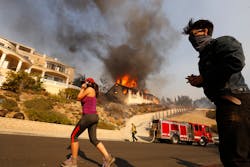Santa Ana Winds Blamed for This Year's Devastating CA Wildfires
LOS ANGELES — When Forest Service meteorologist Tom Rolinski heard that a wildfire had broken out Monday evening in Ventura County, he knew it was going to be a problem.
The Thomas fire started in a known wind corridor on the first day of dry Santa Ana winds that are expected to buffet Southern California for nearly a week. What’s more, it has been a good eight months since a decent rainfall soaked the chaparral hillsides.
“Fires will spread very rapidly in these conditions and basically will be uncontrollable,” Rolinski said.
The blaze was the latest in a series of wildfires that are searing 2017 into the state’s record books. They all have had one thing in common — winds that quickly turn a fire into an inferno.
More than drought or heat, winds can determine whether California burns or doesn’t.
October’s devastating Northern California wildfires exploded on a night when Diablo winds raged across parts of eight counties, tossing embers into Santa Rosa and ultimately claiming 44 lives.
Southern California managed to escape major wildfires during the final years of the state’s big drought because the Santa Anas didn’t blow much.
But this year is different. Fire meteorologists predicted an above-average number of Santa Ana wind days this fall and winter.
There were 14 Santa Ana days — more than twice the norm — in October, when the Canyon 2 fire in Orange County burned dozens of buildings. December typically brings 10 Santa Ana days. By the end of the week, the region will already have been hit by six of them.
The fire danger is expected to be greatest on Thursday, when the online Santa Ana Wildfire Threat Index forecasts an extreme fire threat all the way from Ventura County to the Mexican border.
Southern Californians need to be prepared, said Rolinski, who helped develop the index: Plan an escape route; know where family members are; make sure cell phones are charged.
“We’ve seen this over and over again. When that (online map) lights up and we get a fire in a wind prone area, it’s going to be very difficult to control.”
Indeed, firefighters don’t even try. They concentrate on defending structures and people.
It’s too dangerous to fly retardant- or water-dropping aircraft in high winds, which are also likely to blow any such drops off target.
Though fire officials often say wildfires are tougher to fight in dense scrublands that haven’t burned in decades, wind-driven fires ignore the boundaries of old burns.
Researchers who studied the big 2007 Southern California fires found they blackened more than 50,000 acres that had burned a mere four years earlier during the region’s hellish 2003 fire season.
As for why this Santa Ana season is ramping up after several years of calm, Rolinski says the answer lies in sea surface temperatures in the equatorial Pacific Ocean. In the past six months, that part of the sea has cooled, influencing weather patterns conducive to Santa Anas.
The cooler sea temperatures can cause high pressure systems that push storms to the north and then down into the Great Basin east of California.
The air in the higher-elevation interior is colder than at the coast, creating a pressure gradient that pulls air masses west. As they blow downslope to the coastal areas, they pick up speed, dry out and sometimes heat up.
This week’s winds are cool — about the only good thing you can say about them.
The current prolonged Santa Ana event is a function of the high pressure ridge that is sitting over California, said atmospheric scientist Scott Capps, the principal of Atmospheric Data Solutions.
The fact that the winds started in Ventura County and are working their way south is typical, he added.
Wind strength can vary dramatically depending on the local topography. Tuesday morning, a weather station in the Santa Ana Mountains in Orange County, near Capps’ home, recorded gusts of 80 mph.
They tore off the roof of his backyard chicken coop — but the chickens were safe.
As for whether climate change will diminish or strengthen Santa Ana seasons by affecting the temperature gradients between interior and coastal regions, there is conflicting research.
“It’s a tough question,” said Capps. “I could see it going either way.”
———
©2017 Los Angeles Times
Visit the Los Angeles Times at www.latimes.com
Distributed by Tribune Content Agency, LLC.
